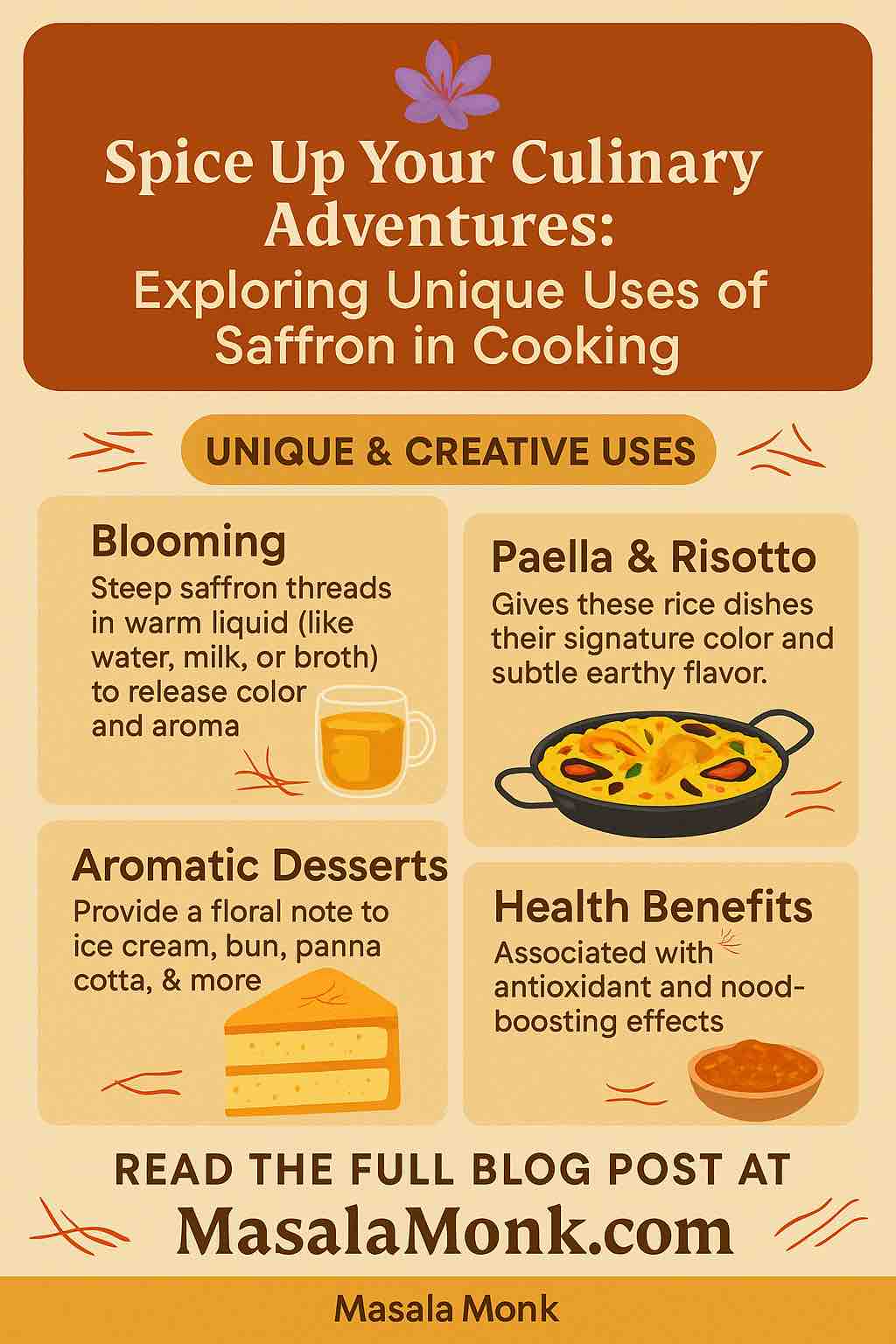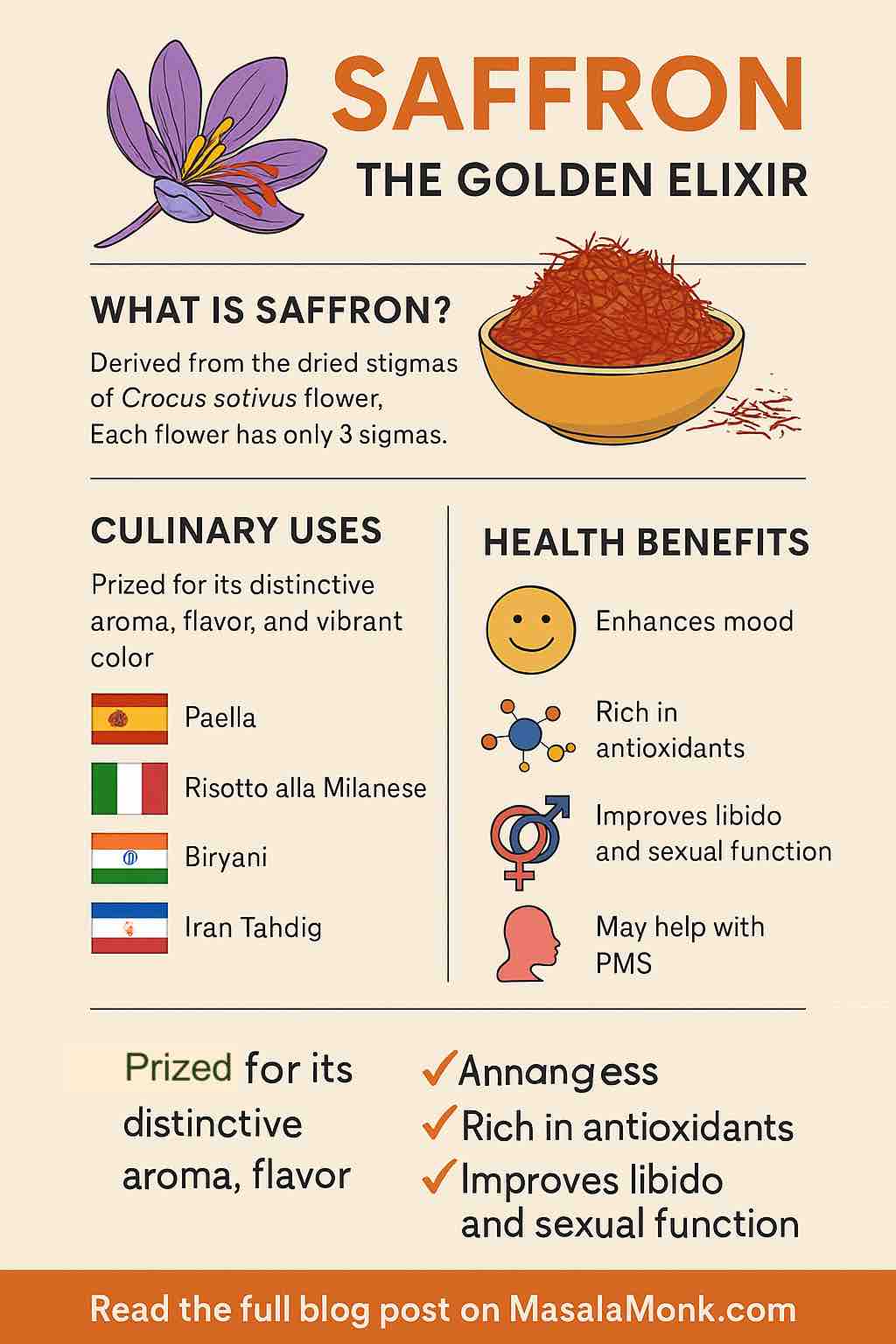
Saffron, often dubbed “red gold,” is one of the most precious and celebrated spices in the culinary world. Derived from the stigmas of the Crocus sativus flower, it brings a distinctive aroma, brilliant golden hue, and subtle earthy flavor to countless dishes. But saffron is more than a luxurious seasoning for risottos and paellas—it’s a versatile ingredient with global influence and contemporary flair.
In this post, we dive deep into saffron’s culinary magic, exploring traditional and innovative uses, practical cooking techniques, and fresh ideas to make your dishes unforgettable.
1. The Essence of Saffron: What Makes It Special?
Saffron is prized for its:
- Color: The golden-yellow tint it imparts to food
- Aroma: Sweet, floral, and hay-like
- Flavor: Complex and earthy, slightly bitter, subtly metallic
These qualities come from the compounds crocin (color), picrocrocin (flavor), and safranal (aroma). The highest quality saffron, often labeled as Super Negin, contains the most concentrated levels of these.
2. How to Use Saffron Properly: Practical Techniques
Saffron is powerful but delicate. To get the most out of it:
- Bloom it: Steep threads in a few tablespoons of warm water, milk, or stock for 10-20 minutes before adding to recipes.
- Grind it: For better distribution, grind the threads with a pinch of sugar or salt using a mortar and pestle.
- Measure with care: A few strands go a long way—use about 2-3 threads per serving to avoid overpowering other flavors.
Storage Tip: Keep saffron in an airtight container away from light and moisture to preserve its potency.
3. Saffron Across the Globe: Traditional Inspirations
Saffron’s cultural reach spans continents. Some classic uses include:
- Iranian/Persian Cuisine: Essential in tahdig, tahchin, and saffron rice, often paired with rosewater and pistachios.
- Indian Cuisine: A key ingredient in biryani, kheer, and saffron milk (kesar doodh).
- Spanish Cuisine: The soul of paella, giving it its signature color and aroma.
- Italian Cuisine: Infuses Risotto alla Milanese with deep color and flavor.
- Swedish Cuisine: Featured in Lussekatter (saffron buns) during St. Lucia’s Day.
4. Unique & Modern Uses of Saffron
Break away from tradition with these creative saffron applications:
• Saffron-Infused Pasta
Make fresh pasta dough using saffron-steeped water for vibrant, golden noodles that pair wonderfully with seafood or creamy sauces.
• Saffron Syrup
Create a simple syrup with sugar, water, and bloomed saffron. Drizzle it over pancakes, yogurt, or fruit salads. Also great in cocktails and mocktails.
• Saffron Butter
Blend bloomed saffron into softened butter with garlic or citrus zest. Use it to top grilled fish, roasted vegetables, or warm bread.
• Saffron Salt
Mix ground saffron with flaky sea salt to finish dishes like roast chicken, potatoes, or avocado toast.
• Saffron Desserts
Infuse custards, panna cottas, or ice cream bases with saffron for a luxurious twist. Pairs well with cardamom, pistachios, and honey.
5. Pairing Saffron with Other Ingredients
Saffron shines when paired thoughtfully. Consider combining it with:
- Herbs & Spices: Cardamom, cinnamon, cumin, rose, turmeric
- Proteins: Chicken, seafood, lamb, eggs
- Grains: Basmati rice, arborio rice, couscous, bulgur
- Dairy: Cream, yogurt, paneer, butter
- Floral & Sweet: Rosewater, orange blossom, honey, citrus
6. Health Benefits Worth Noting
Saffron isn’t just delicious—it’s also linked to several health benefits:
- Mood support: May reduce symptoms of anxiety and depression
- Antioxidant properties: Rich in crocin and safranal
- Anti-inflammatory: Supports immune and cardiovascular health
- Digestive aid: Traditionally used to ease bloating and cramps
7. Buyer’s Guide: Choosing Quality Saffron
To avoid fakes and low-grade products:
- Look for deep red threads with orange tips
- Avoid powdered saffron (easier to adulterate)
- Buy from reputable sources with transparency about origin (Iran, Spain, Kashmir)
- If it’s cheap, it’s likely not real saffron
8. Quick Recipes to Try
Saffron Tea
Steep 3-5 threads in hot water with honey and lemon for a soothing drink.
Saffron Rice Pilaf
Sauté onion and garlic in butter, stir in rice and bloomed saffron, add stock, cook until fluffy. Garnish with almonds and parsley.
Saffron Yogurt Dip
Mix Greek yogurt with bloomed saffron, lemon juice, and garlic. Serve with flatbread or grilled veggies.
Final Thoughts
Saffron is more than a spice—it’s an experience. Whether you’re cooking an old family recipe or experimenting with new flavors, a few strands can transform a dish from simple to spectacular. So go ahead, embrace saffron in your kitchen, and let your culinary adventures shine bright gold.
Got a favorite saffron dish? Or want personalized ideas based on your favorite cuisines? Drop a comment or reach out—let’s keep the saffron inspiration flowing!
📚 Frequently Asked Questions (FAQs)
1. How much saffron should I use in a dish?
A little goes a long way. Use about 2–3 threads per serving, or roughly 15–20 threads for a dish serving 4–6 people. Overuse can lead to bitterness.
2. What’s the best way to extract flavor and color from saffron?
Bloom it in warm water, broth, or milk for 10–20 minutes. This releases crocin (color) and safranal (aroma), giving you the most depth of flavor and vibrant color.
3. Can I grind saffron instead of blooming it?
Yes. Grinding saffron (often with a pinch of sugar or salt) using a mortar and pestle is great for even distribution—ideal in dry rubs or baked goods.
4. How do I know if saffron is real or fake?
Real saffron has deep red threads with orange/yellow tips, a sweet hay-like smell, and turns water golden yellow (not red). Avoid powdered saffron unless it’s from a trusted source.
5. Is there a difference between Iranian, Spanish, and Kashmiri saffron?
Yes.
- Iranian saffron is bold, intense, and widely available.
- Spanish saffron (like Mancha) is milder and often used in paella.
- Kashmiri saffron is highly aromatic, deep red, and prized for desserts.
6. What types of dishes can I add saffron to besides rice?
Beyond rice, use it in pasta, breads, seafood stews, sauces, desserts, syrups, teas, marinades, and compound butters. It pairs well with both savory and sweet elements.
7. Can I store bloomed saffron water for later use?
Yes, but for best potency, use it within 24–48 hours. Store in the fridge in an airtight container.
8. Is saffron safe to consume every day?
In culinary amounts, yes. It’s also used in supplements, but excessive intake (several grams daily) may cause side effects. Stick to moderate, food-level usage.
9. Is saffron gluten-free and vegan?
Absolutely. Pure saffron is naturally gluten-free, vegan, and non-GMO, making it suitable for nearly all dietary lifestyles.
10. Where can I buy authentic saffron online?
Look for certified suppliers from Iran, Spain, or Kashmir. Reputable retailers include specialty spice shops, Middle Eastern grocery stores, or websites like Saffron Store, Rumi Spice, or Saffron Ice. Ensure the origin and grading (e.g., Super Negin) are clearly listed.










